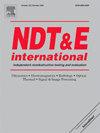Influence of antenna polarization and moisture content on detection of GFPR bars in concrete using ground penetrating radar
IF 4.5
2区 材料科学
Q1 MATERIALS SCIENCE, CHARACTERIZATION & TESTING
引用次数: 0
Abstract
Glass fiber-reinforced polymer (GFRP) has recently emerged as a promising alternative to traditional steel reinforcement in concrete due to its superior durability. However, conventional non-destructive testing (NDT) methods often face limitations in detecting GFRP rebars, posing challenges for the maintenance and safety assessment of civil infrastructure. This study evaluates the applicability of ground-penetrating radar (GPR) for detecting GFRP reinforcement in concrete through both numerical simulation and experimental validation. The investigation focuses on the influence of antenna polarization and concrete moisture conditions on electromagnetic (EM) wave-based detection. Numerical simulations confirmed that increased moisture in concrete enhances dielectric contrast, thereby improving the visibility of GFRP bars. For experimental validation, two concrete specimens—a beam and a slab embedded with GFRP reinforcement—were prepared and tested. The results revealed that EM wave reflection energy increased by up to 17.0 % and 15.8 % under wet conditions using cross and normal polarizations, respectively. These findings underscore the significance of selecting appropriate antenna polarization and accounting for moisture conditions to improve the detection accuracy of GFRP rebars using GPR.
天线极化和含水率对探地雷达探测混凝土中gpr杆的影响
玻璃纤维增强聚合物(GFRP)由于其优异的耐久性,最近成为传统钢筋混凝土的有希望的替代品。然而,传统的无损检测(NDT)方法在检测玻璃钢钢筋时往往存在局限性,给民用基础设施的维护和安全评估带来了挑战。本研究通过数值模拟和实验验证来评估探地雷达(GPR)探测混凝土中玻璃钢加固的适用性。重点研究了天线极化和混凝土湿度条件对电磁探测的影响。数值模拟证实,混凝土中水分的增加提高了介电对比度,从而提高了玻璃钢杆的可视性。为了进行试验验证,制备并测试了两个混凝土试件-一根梁和一根嵌有GFRP加固的板。结果表明,在潮湿条件下,交叉极化和正向极化的电磁波反射能量分别增加了17.0%和15.8%。这些结果强调了选择合适的天线极化和考虑湿度条件对提高GFRP钢筋的探地雷达探测精度的重要性。
本文章由计算机程序翻译,如有差异,请以英文原文为准。
求助全文
约1分钟内获得全文
求助全文
来源期刊

Ndt & E International
工程技术-材料科学:表征与测试
CiteScore
7.20
自引率
9.50%
发文量
121
审稿时长
55 days
期刊介绍:
NDT&E international publishes peer-reviewed results of original research and development in all categories of the fields of nondestructive testing and evaluation including ultrasonics, electromagnetics, radiography, optical and thermal methods. In addition to traditional NDE topics, the emerging technology area of inspection of civil structures and materials is also emphasized. The journal publishes original papers on research and development of new inspection techniques and methods, as well as on novel and innovative applications of established methods. Papers on NDE sensors and their applications both for inspection and process control, as well as papers describing novel NDE systems for structural health monitoring and their performance in industrial settings are also considered. Other regular features include international news, new equipment and a calendar of forthcoming worldwide meetings. This journal is listed in Current Contents.
 求助内容:
求助内容: 应助结果提醒方式:
应助结果提醒方式:


